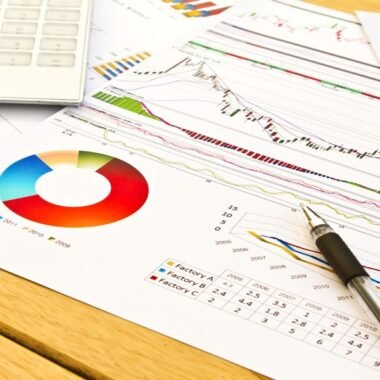Summary: Autocorrelation is a statistical tool used to analyse time series data by measuring the correlation between a variable and its past values. It helps identify patterns, trends, and seasonality, aiding in forecasting and model selection. This guide covers autocorrelation basics, calculations, and practical applications.
Introduction
Imagine analysing the daily closing prices of a stock, such as Google shares, over a few months. You notice that when the stock price rises one day, it often rises the next day too. This pattern indicates a relationship between consecutive values in the dataset—a phenomenon known as autocorrelation.
Similarly, consider global earthquake data over 100 years; patterns in the frequency of high-magnitude earthquakes suggest that past occurrences influence future ones. These examples highlight how autocorrelation helps uncover underlying patterns in time series data.
Autocorrelation is a fundamental concept in Time Series Analysis, widely used in fields like econometrics, finance, and signal processing. It measures the relationship between a variable’s current value and its past values over successive time intervals.
This blog explores autocorrelation, its significance, and related concepts such as partial autocorrelation, the Durbin-Watson test, and methods to handle autocorrelation effectively.
Key Takeaways
- Autocorrelation analyses time series data for patterns and trends effectively.
- It measures correlation between a variable and its lagged versions.
- Autocorrelation helps identify seasonality and cyclical patterns in data.
- It aids in selecting appropriate models for time series forecasting.
- Autocorrelation plots visualize relationships between observations over time.
Understanding Autocorrelation
Autocorrelation, also known as serial correlation, quantifies the similarity between observations in a time series at different time lags. Unlike standard correlation, which measures the relationship between two separate variables, autocorrelation focuses on the same variable across different time periods.
Key Features of Autocorrelation
- Positive Autocorrelation: When high values are followed by high values (or low by low).
- Negative Autocorrelation: When high values are followed by low values (and vice versa).
- Zero Autocorrelation: Indicates no relationship between current and lagged values.
For example:
- In weather forecasting, if it rains today, it’s more likely to rain tomorrow (positive autocorrelation).
- In stock prices, a sudden rise may be followed by a drop (negative autocorrelation).
What is Partial Autocorrelation?
Partial autocorrelation isolates the direct relationship between a variable and its lagged values by removing the effects of intermediate lags. For instance, the partial autocorrelation at lag 3 measures the correlation between today’s value and the value three days ago, excluding any influence from lag 1 or lag 2.
Key Features of Partial Autocorrelation
- Definition: Correlation between a variable and its lagged value after accounting for correlations at shorter lags.
- Removes Indirect Effects: Focuses solely on direct relationships.
- Visualization: Represented using a Partial Autocorrelation Function (PACF) plot, which highlights significant direct correlations at specific lags.
Applications
- Determining the order of autoregressive (AR) terms in ARIMA models.
- Refining models by identifying significant lags to include.
Autocorrelation vs Partial Autocorrelation
Autocorrelation and partial autocorrelation are both tools used in Time Series Analysis to understand the relationships between observations at different time points. However, they serve distinct purposes and provide different insights into the structure of a time series.
Autocorrelation Function (ACF)
It measures the linear dependence of a time series with itself at different points in time. It calculates the correlation between an observation and its lagged versions without controlling for the effects of intervening observation.
- Use: It is useful for identifying patterns such as trends, seasonality, and cycles in time series data. It helps in determining the order of moving-average (MA) models by observing how quickly the autocorrelation values decay.
- Interpretation: A high autocorrelation at a specific lag indicates a strong linear relationship between the current observation and the observation at that lag. Its plots are often used to assess stationarity and to identify potential orders for MA models.
Partial Autocorrelation Function (PACF)
It measures the correlation between an observation and its lagged versions after removing the effects of all intervening observations. It isolates the unique correlation between two observations that is not explained by shorter lags.
- Use: Partial autocorrelation is crucial for identifying the order of autoregressive (AR) models. By examining the PACF plot, one can determine the appropriate lag order for an AR model, since the values typically cut off after the order of the AR model.
- Interpretation: A nonzero partial autocorrelation at a specific lag indicates a direct relationship between the current observation and the observation at that lag that is not accounted for by shorter lags. The PACF plot is used to identify the order of AR models by looking for the point where the partial autocorrelations become insignificant.
Durbin-Watson Test for Autocorrelation
The Durbin-Watson test is a statistical method used to detect autocorrelation in residuals from regression analysis. It helps identify whether errors are independent or exhibit serial correlation.
Steps to Perform Durbin-Watson Test
- Fit a regression model.
- Calculate residuals (differences between observed and predicted values).
- Compute the Durbin-Watson statistic:
DW=∑t=2n(et−et−1)2∑t=1net2DW=∑t=1net2∑t=2n(et−et−1)2
Where etet is the residual at time tt.
Interpreting Durbin-Watson Values
- DW≈2DW≈2: No autocorrelation.
- DW<2DW<2: Positive autocorrelation.
- DW>2DW>2: Negative autocorrelation.
How to Calculate Autocorrelation in Python
To calculate autocorrelation in Python, you can use several methods depending on your requirements. Below are some common approaches:
1. Using numpy.correlate
This method computes directly correlating a signal with itself.
Source: Perplexity.ai
This method normalizes the result by dividing by the variance and the decreasing number of terms for each lag.
2. Using pandas.Series.autocorr
This is a simple way to compute autocorrelation for a specific lag.
Source: Perplexity.ai
3. Using statsmodels.tsa.stattools.acf
This method is helpful in computing autocorrelation function for multiple lags.
Source: Perplexity.ai
The acf function is part of the statsmodels library and is useful for analysing time series data series data.
4. Manual Calculation
If you need full control over the calculation, you can implement it manually.
Source: Perplexity.ai
Ways to Handle Autocorrelation
When autocorrelation exists in your data, it can distort model accuracy. By employing these strategies, researchers and analysts can effectively manage it, leading to more accurate and reliable statistical models and forecasts.Here are effective ways to address it:
Improve Model Specification
Enhance models by adding relevant variables to capture underlying patterns and trends in data, ensuring that the model accurately reflects the relationships within the time series.
Improving model specification involves incorporating additional variables or features that can help explain the autocorrelation observed in the data. This might include time-based predictors, seasonal indicators, or other relevant factors that influence the time series.
Example:
- Scenario: Analyzing monthly sales data that shows strong seasonal patterns.
- Action: Include seasonal dummy variables (e.g., winter, spring, summer, fall) in the regression model to capture these patterns.
- Benefit: The model better accounts for seasonal fluctuations, reducing autocorrelation and improving forecasting accuracy.
Use Autoregressive Models
Apply AR, MA, or ARIMA models to explicitly incorporate autocorrelation into the forecasting process, leveraging past values to predict future outcomes.
Autoregressive models are specifically designed to handle autocorrelation by using past values of the time series as predictors. AR models use past values of the series itself, MA models use past errors, and ARIMA models combine both.
Example:
- Scenario: Forecasting stock prices that exhibit both trends and seasonality.
- Action: Use an ARIMA model to capture these patterns. For instance, ARIMA(1,1,1) includes one autoregressive term, one differencing term, and one moving-average term.
- Benefit: The model effectively incorporates historical trends and seasonal patterns, improving the accuracy of stock price forecasts.
Apply Transformations
Transform data by stabilizing variance or removing trends, making it more suitable for analysis.
Data transformations can make the data more stationary. Common transformations include differencing, logarithmic transformation, and Box-Cox transformations.
Example:
- Scenario: Analyzing GDP growth rates that show strong trends over time.
- Action: Apply differencing to remove the trend. For example, calculate the difference in GDP growth from one quarter to the next.
- Benefit: The transformed data becomes more stationary, reducing autocorrelation and allowing for more accurate modeling.
Generalized Least Squares (GLS)
Employ GLS to correct for autocorrelated residuals in regression models, providing more accurate estimates and standard errors.
GLS is an extension of ordinary least squares (OLS). It adjusts the estimation process to ensure that the standard errors are correctly calculated.
Example:
- Scenario: Conduct an econometric analysis where residuals show autocorrelation.
- Action: Use GLS instead of OLS to account for the autocorrelation in residuals.
- Benefit: GLS provides more reliable estimates of coefficients and their standard errors, improving the validity of statistical tests.
Include Lagged Variables
Add lagged dependent variables as predictors to capture temporal relationships and reduce autocorrelation in residuals.
Including lagged variables in a regression model helps capture the temporal dependencies within the data. This approach shows how past values influence current outcomes.
Example:
- Scenario: Predicting future sales based on past sales data.
- Action: Include lagged sales figures (e.g., sales from the previous quarter) as predictors in the model.
- Benefit: The model better accounts for temporal dependencies, and improves forecasting accuracy.
Conclusion
In conclusion, autocorrelation measures the correlation of a time series with its own past values, revealing patterns and dependencies over time. Defined mathematically, it helps identify trends and cyclic behaviors within data. By applying it, the analysts can enhance forecasting accuracy and gain insights into temporal relationships, making it a vital tool in statistics and time series analysis.
Frequently Asked Questions
What Is The Main Purpose Of Autocorrelation In Time Series Analysis?
It identifies patterns and relationships within time series data, aiding trend detection and forecasting.
How Does Autocorrelation Affect Predictive Modelling?
It violates independence assumptions in models like linear regression, leading to biased estimates and reduced accuracy.
What Is The Difference Between Autocorrelation And Partial Autocorrelation?
It measures total correlation across lags; partial autocorrelation isolates direct effects for specific lags.
How Can I Detect And Test For Autocorrelation In My Dataset?
Use tools like ACF plots for visual detection or statistical tests like Durbin-Watson for validation.




